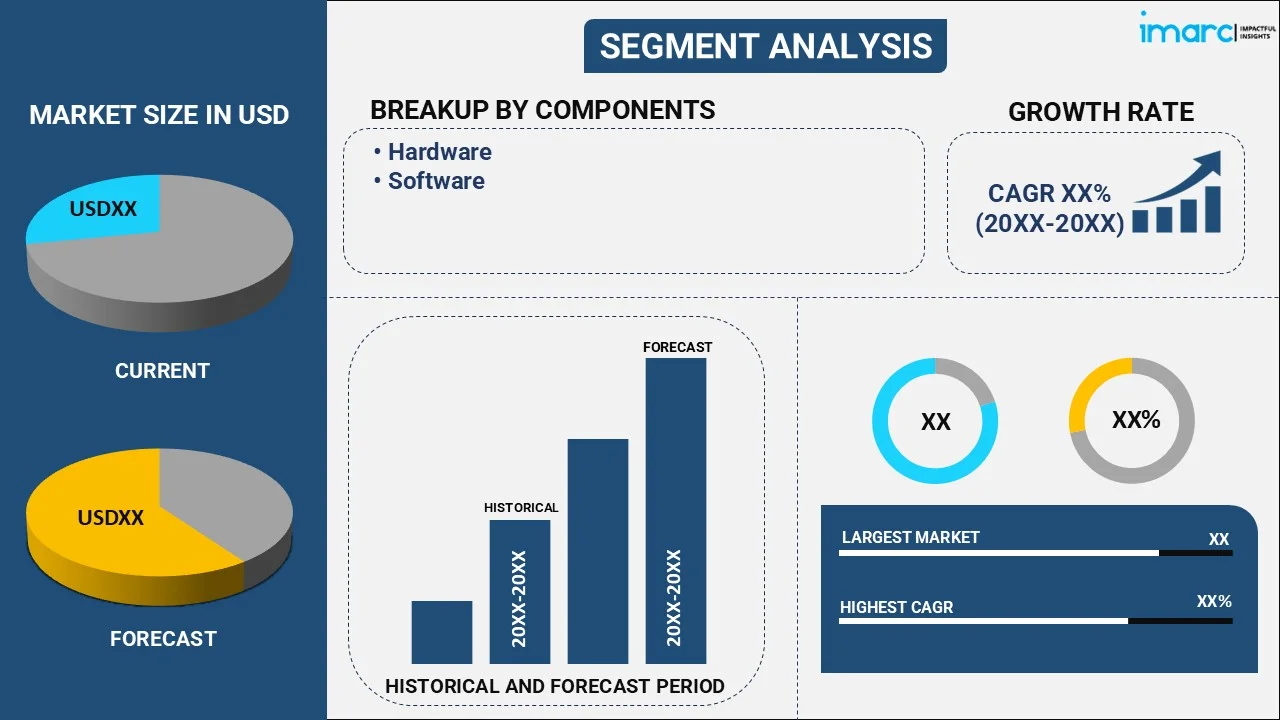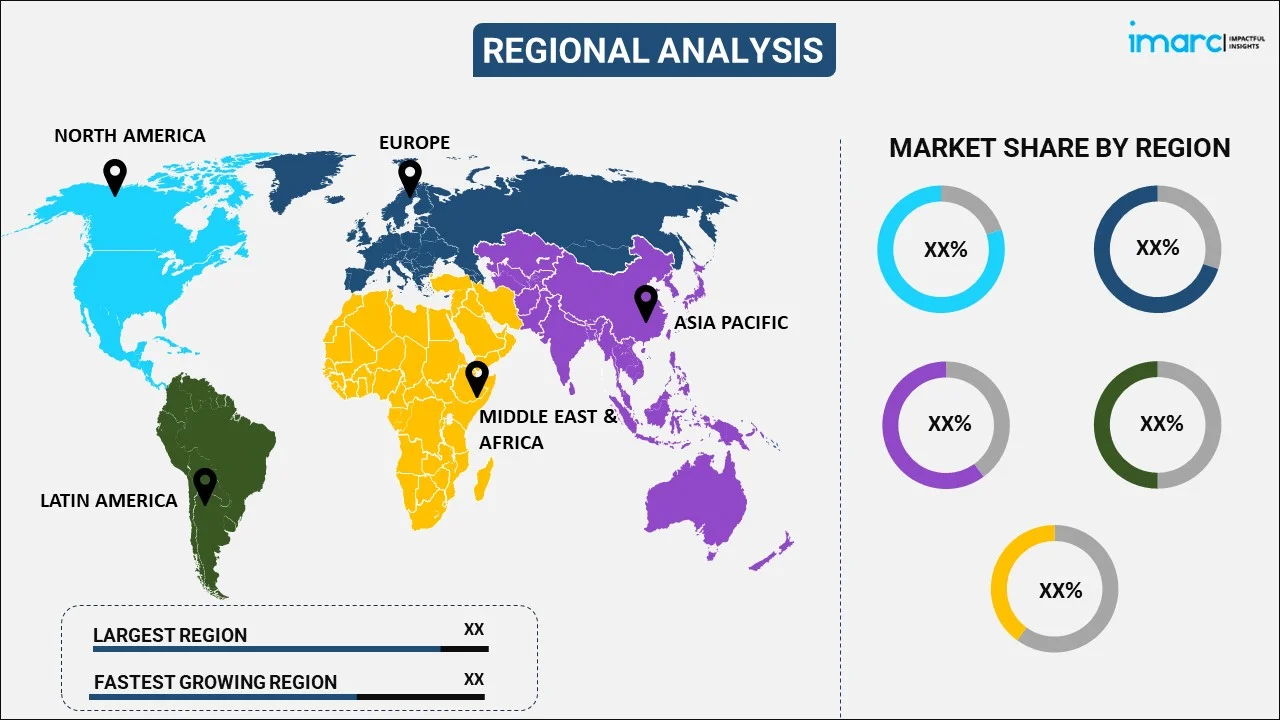
Smart Mirror Market Report by Component (Hardware, Software), Type (Interior Mirrors, Exterior Mirrors), Functionality (Connected Mirror, Non-Connected Mirror), Technology (Self-Dimming, Self-Cleaning, Self-Repairing), End User (Automotive, Healthcare, Residential, and Others), and Region 2025-2033
Smart Mirror Market Overview:
The global smart mirror market size reached USD 3.3 Billion in 2024. Looking forward, IMARC Group expects the market to reach USD 7.7 Billion by 2033, exhibiting a growth rate (CAGR) of 9.8% during 2025-2033. There are numerous factors that are driving the market, which include the rising focus on health and wellness due to the awareness about the importance of maintaining an active lifestyle, increasing adoption of automobiles, and integration of advanced technologies.
|
Report Attribute
|
Key Statistics
|
|---|---|
|
Base Year
|
2024
|
|
Forecast Years
|
2025-2033
|
|
Historical Years
|
2019-2024
|
|
Market Size in 2024
|
USD 3.3 Billion |
|
Market Forecast in 2033
|
USD 7.7 Billion |
| Market Growth Rate (2025-2033) | 9.8% |
Smart Mirror Market Analysis:
- Major Market Drivers: The smart mirror market size is experiencing strong growth because of the increasing adoption of smart homes and expanding use in commercial sectors.
- Key Market Trends: The rising focus on health and wellness and the integration of advanced technologies are key smart mirror market trends.
- Geographical Trends: North America exhibits a clear dominance, accounting for the largest smart mirror market share owing to the trend of smart homes among individuals.
- Competitive Landscape: Various market players in the smart mirror industry include Archello, Dension Ltd, Electric Mirror Inc., Ficosa International SA (Panasonic Corporation), Gentex Corporation, Japan Display Inc., Magna International Inc., Murakami Corporation, Samsung Electronics Co. Ltd, Seura, among many others.
- Challenges and Opportunities: Privacy and security concerns represent a key market challenge. Nonetheless, the expansion in healthcare applications, along with increasing concerns about environmental sustainability, is anticipated to overcome these challenges and offer recent market opportunities.

Smart Mirror Market Trends:
Rising Focus on Health and Wellness
As per the research report of the IMARC Group, the global health and wellness market reached USD 3,670.4 Billion in 2023. The increasing emphasis on health and wellness among individuals is catalyzing the demand for smart mirrors. These mirrors have a range of capabilities that meet the needs of consumers who are becoming more interested in managing their own health. Fitness and health-conscious people are using mirrors that have health tracking features like posture correction, heart rate monitoring, and body composition analysis. Furthermore, these mirrors have fitness apps that provide personalized workout routines and allow individuals to exercise at home with real time feedback.
Technological Advancements
The integration of advanced technologies like artificial intelligence (AI) and the Internet of Things (IoT) is offering a favorable smart mirror market outlook. Smart mirrors that integrate AI can identify users by using face recognition technology. They can offer individualized experiences like tailored workout plans, skincare advice, and even health diagnoses based on the user's appearance, such as changes in skin tone or stress levels. Furthermore, smart mirrors may easily communicate with other smart gadgets in a house or place of business owing to the IoT connectivity. In addition, companies are incorporating these technologies to provide enhanced user experience. For instance, Baracoda unveiled BMind, the world’s first artificial intelligence (AI)-powered smart mirror for mental wellness on 7 January 2024. It acts as a health companion capable of identifying mood and helping manage stress. It is built on a new generation smart mirror software from the CareOS platform, BMind provides personalized recommendations and experiences based on a user’s mental state, as part of a seamless and touchless experience with gesture recognition, voice command, and intent detection.
Increasing Adoption of Automobiles
The International Energy Agency (IEA) states that there were around 14 million electric cars sold out in 2023. The rising adoption of vehicles among the masses is propelling the smart mirror market growth. Automakers and consumers find smart mirrors an appealing addition since they improve functionality, safety, and convenience. In modern vehicles, smart rearview mirrors in cars are equipped with cameras that expand the field of view, removing blind spots and enhancing visibility in adverse weather conditions. These mirrors can switch between a traditional reflective mode and a digital display to show live camera feeds, offering enhanced safety for drivers. Moreover, automakers are incorporating smart mirrors with advanced driver-assistance systems (ADAS) features like lane departure warnings, blind spot detection, and parking assistance.
Smart Mirror Market Segmentation:
IMARC Group provides an analysis of the key trends in each segment of the market, along with forecasts at the global, regional, and country levels for 2025-2033. Our report has categorized the market based on component, type, functionality, technology, and end user.
Breakup by Component:

- Hardware
- Software
Hardware accounts for the majority of the market share
The report has provided a detailed breakup and analysis of the market based on the component. This includes hardware and software. According to the report, hardware represented the largest segment.
Hardware comprises an extensive range of physical components required to build these advanced devices. Smart mirrors rely on high-quality display screens, sensors, cameras, and processors to function effectively. The integration of touchscreens, microphones, and speakers also plays a crucial role in enhancing user interaction. These hardware elements enable various functionalities such as gesture control, voice recognition, and seamless connectivity with other smart devices. The growing demand for sophisticated hardware components across various applications is offering a favorable market outlook.
Breakup by Type:
- Interior Mirrors
- Exterior Mirrors
Interior mirrors hold the largest share of the industry
A detailed breakup and analysis of the market based on the type have also been provided in the report. This includes interior mirrors and exterior mirrors. According to the report, interior mirrors account for the largest market share.
Interior mirrors are usually integrated into the cabin of vehicles, offering drivers enhanced features such as rearview camera displays, blind spot monitoring, and automatic dimming to reduce glare from headlights. The convenience and safety provided by smart interior mirrors are making them a popular feature in both luxury and mid-range vehicles. In addition, the rising employment of interior mirrors in vehicles, as they provide real time information and improve driver awareness, is supporting the market growth.
Breakup by Functionality:
- Connected Mirror
- Non-Connected Mirror
Connected mirror represents the leading market segment
The report has provided a detailed breakup and analysis of the market based on the functionality. This includes connected mirror and non-connected Mirror. According to the report, connected mirror represents the largest segment.
Connected mirror can be easily integrated with other smart devices and systems, providing enhanced connectivity and functionality. These mirrors are equipped with the IoT technology, allowing them to link seamlessly with smartphones, home automation systems, and cloud-based platforms. This connectivity enables users to control smart home devices, receive real time updates, and access personalized content, all through the mirror interface. The rising consumer demand for connected devices in both homes and vehicles is contributing to the market growth.
Breakup by Technology:
- Self-Dimming
- Self-Cleaning
- Self-Repairing
Self-dimming exhibits a clear dominance in the market
A detailed breakup and analysis of the market based on the technology have also been provided in the report. This includes self-dimming, self-cleaning, and self-repairing. According to the report, self-dimming accounts for the largest market share.
Self-dimming mirrors automatically change their brightness to compensate for shifting lighting such as headlight glare during nighttime driving. This feature significantly enhances driver safety by lowering eye strain and improving visibility, making it a popular choice among automakers and consumers. Self-dimming mirror demand is being driven by an increase in the use of ADAS-equipped automobiles. Additional features like rearview cameras and sensors to help with parking and lane changes are frequently added into these mirrors.
Breakup by End User:
- Automotive
- Healthcare
- Residential
- Others
Automotive dominates the market
The report has provided a detailed breakup and analysis of the market based on the end user. This includes automotive, healthcare, residential, and others. According to the report, automotive represents the largest segment.
In the automotive sector, smart mirrors, particularly rearview and side mirrors, are integrated with various safety technologies like blind-spot detection, lane departure warnings, rearview cameras, and parking assistance. These features enhance driver visibility and safety, making them highly desirable in both luxury and mid-range vehicles. As the automotive industry moves toward autonomous and electric vehicles (EVs), smart mirrors are becoming standard components in many cars. They not only improve safety but also enhance the overall driving experience by offering features like auto-dimming, digital displays, and integration with other in-vehicle systems.
Breakup by Region:

- North America
- United States
- Canada
- Asia-Pacific
- China
- Japan
- India
- South Korea
- Australia
- Indonesia
- Others
- Europe
- Germany
- France
- United Kingdom
- Italy
- Spain
- Russia
- Others
- Latin America
- Brazil
- Mexico
- Others
- Middle East and Africa
North America leads the market, accounting for the largest smart mirror market share
The report has also provided a comprehensive smart mirror market analysis of all the major regions, which include North America (the United States and Canada); Asia Pacific (China, Japan, India, South Korea, Australia, Indonesia, and others); Europe (Germany, France, the United Kingdom, Italy, Spain, Russia, and others); Latin America (Brazil, Mexico, and others); and the Middle East and Africa. According to the report, North America represents the largest regional market for smart mirror.
United States motor vehicle production was reported 10,611,555.000 units in December 2023, as per CEIC. The North America’s strong presence of major automotive manufacturers and technology companies is leading to widespread integration of smart mirrors in vehicles. Moreover, the growing trend of smart homes in region is contributing to the market growth. There is an increase in the demand for smart mirrors in residential settings. People in the region are increasingly incorporating smart mirrors as part of their home automation systems, using them for tasks such as voice assistance, fitness tracking, and personalized content display.
Competitive Landscape:
The market research report has also provided a comprehensive analysis of the competitive landscape in the market. Detailed profiles of all major companies have also been provided. Some of the major market players in the smart mirror industry include:
- Archello
- Dension Ltd
- Electric Mirror Inc.
- Ficosa International SA (Panasonic Corporation)
- Gentex Corporation
- Japan Display Inc.
- Magna International Inc.
- Murakami Corporation
- Samsung Electronics Co. Ltd
- Seura
(Please note that this is only a partial list of the key players, and the complete list is provided in the report.)
Top players are focusing on integrating advanced features in smart mirrors. They are making their products more energy-efficient and eco-friendly to grab the attention of a wider consumer base. They are also forming partnerships with automotive manufacturers, tech companies, and healthcare providers to expand the applications of smart mirrors. For example, on 9 June 2023, Gentex Corporation equipped Peugeot’s all-new 9X8 Hybrid Hypercar with an intelligent rear vision system designed to optimize the vehicle’s rearward view. Peugeot Sport and Gentex partnered to implement a state-of-the-art digital rearview mirror that will enhance the driver's visibility and situational awareness during the race. The mirror captures video from a rearward-facing camera and streams it to a mirror-integrated liquid-crystal display (LCD), providing drivers with a wide and unobstructed view behind the vehicle. Moreover, the passenger-vehicle version of the Gentex digital rearview mirror offers bi-modal functionality.
Smart Mirror Market News:
- 13 February 2024: Alter, a biometric-based at-home fitness and wellness ecosystem, launched a DNA fitness system, smart mirror. Alter’s 50-lb mirrored device is the essential component for offering a pathway to personalized workouts, real time heart rate tracking and AI-powered form correction.
- 18 June 2024: Samsung unveiled a groundbreaking innovation with the launch of their latest E Ink smart mirror technology. This new device, a sophisticated smart mirror, integrates E Ink Spectra 6 display technology into a sleek 32-inch TV. This move marks a significant departure from Samsung’s traditional focus on LCD and organic light-emitting diode (OLED) panels, signaling their entry into the e-paper display sector.
Smart Mirror Market Report Scope:
| Report Features | Details |
|---|---|
| Base Year of the Analysis | 2024 |
| Historical Period | 2019-2024 |
| Forecast Period | 2025-2033 |
| Units | Billion USD |
| Scope of the Report | Exploration of Historical Trends and Market Outlook, Industry Catalysts and Challenges, Segment-Wise Historical and Future Market Assessment:
|
| Components Covered | Hardware, Software |
| Types Covered | Interior Mirrors, Exterior Mirrors |
| Functionalities Covered | Connected Mirror, Non-Connected Mirror |
| Technologies Covered | Self-Dimming, Self-Cleaning, Self-Repairing |
| End Users Covered | Automotive, Healthcare, Residential, Others |
| Regions Covered | Asia Pacific, Europe, North America, Latin America, Middle East and Africa |
| Countries Covered | United States, Canada, Germany, France, United Kingdom, Italy, Spain, Russia, China, Japan, India, South Korea, Australia, Indonesia, Brazil, Mexico |
| Companies Covered | Archello, Dension Ltd, Electric Mirror Inc., Ficosa International SA (Panasonic Corporation), Gentex Corporation, Japan Display Inc., Magna International Inc., Murakami Corporation, Samsung Electronics Co. Ltd, Seura, etc. |
| Customization Scope | 10% Free Customization |
| Post-Sale Analyst Support | 10-12 Weeks |
| Delivery Format | PDF and Excel through Email (We can also provide the editable version of the report in PPT/Word format on special request) |
Key Benefits for Stakeholders:
- IMARC’s industry report offers a comprehensive quantitative analysis of various market segments, historical and current market trends, market forecasts, and dynamics of the smart mirror market from 2019-2033.
- The research report provides the latest information on the market drivers, challenges, and opportunities in the global market.
- The study maps the leading, as well as the fastest-growing, regional markets. It further enables stakeholders to identify the key country-level markets within each region.
- Porter's five forces analysis assists stakeholders in assessing the impact of new entrants, competitive rivalry, supplier power, buyer power, and the threat of substitution. It helps stakeholders to analyze the level of competition within the smart mirror industry and its attractiveness.
- The competitive landscape allows stakeholders to understand their competitive environment and provides insight into the current positions of key players in the market.
Key Questions Answered in This Report
The global smart mirror market was valued at USD 3.3 Billion in 2024.
We expect the global smart mirror market to exhibit a CAGR of 9.8% during 2025-2033.
The sudden outbreak of the COVID-19 pandemic had led to the implementation of stringent lockdown regulations across several nations resulting in temporary closure of various end-use industries for smart mirrors.
The rising adoption of smart mirror in the passenger and light-commercial vehicles with Advanced Driver Assistance Systems (ADAS) for providing blind spot vision and enhancing the safety of the driver and the passengers, is primarily driving the global smart mirror market.
Based on the component, the global smart mirror market can be divided into hardware and software. Currently, hardware exhibits a clear dominance in the market.
Based on the type, the global smart mirror market has been bifurcated into interior mirrors and exterior mirrors, where interior mirrors currently hold the majority of the total market share.
Based on the functionality, the global smart mirror market can be segregated into connected mirror and non-connected mirror. Currently, connected mirror accounts for the largest market share.
Based on the technology, the global smart mirror market has been categorized self-dimming, self-cleaning, and self-repairing. Among these, self-dimming currently holds the majority of the global market share.
Based on the end user, the global smart mirror market can be divided into automotive, healthcare, residential, and others. Currently, the automotive sector exhibits a clear dominance in the market.
On a regional level, the market has been classified into North America, Asia-Pacific, Europe, Latin America, and Middle East and Africa, where North America currently dominates the global market.
Some of the major players in the global smart mirror market include Archello, Dension Ltd, Electric Mirror Inc., Ficosa International SA (Panasonic Corporation), Gentex Corporation, Japan Display Inc., Magna International Inc., Murakami Corporation, Samsung Electronics Co. Ltd, and Seura.
Need more help?
- Speak to our experienced analysts for insights on the current market scenarios.
- Include additional segments and countries to customize the report as per your requirement.
- Gain an unparalleled competitive advantage in your domain by understanding how to utilize the report and positively impacting your operations and revenue.
- For further assistance, please connect with our analysts.
 Inquire Before Buying
Inquire Before Buying
 Speak to an Analyst
Speak to an Analyst
 Request Brochure
Request Brochure
 Request Customization
Request Customization




.webp)




.webp)












